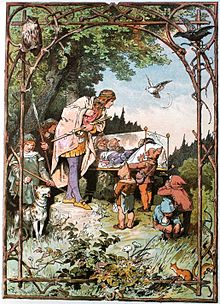Snow White and the Seven Dwarfs
| Snow White | |
|---|---|

Schneewittchen by Alexander Zick
|
|
| Folk tale | |
| Name | Snow White |
| Data | |
| Aarne-Thompson grouping | 709 |
| Country | Germany |
"Snow White" is a nineteenth-century German fairy tale which is today known widely across the Western world. The Brothers Grimm published it in 1812 in the first edition of their collection Grimms' Fairy Tales. It was titled in German: Sneewittchen (in modern orthography Schneewittchen) and numbered as Tale 53. The name "Sneewittchen" was Low German and in the first version it was translated with "Schneeweißchen". The Grimms completed their final revision of the story in 1854.
The fairy tale features such elements as the magic mirror, the poisoned apple, the glass coffin, and the characters of the evil queen and the Seven Dwarfs. The seven dwarfs were first given individual names in the 1912 Broadway play Snow White and the Seven Dwarfs and then given different names in Walt Disney's 1937 film Snow White and the Seven Dwarfs. The Grimm story, which is commonly referred to as "Snow White", should not be confused with the story of "Snow White and Rose Red" (in German "Schneeweißchen und Rosenrot"), another fairy tale collected by the Brothers Grimm.
In the Aarne–Thompson folklore classification, tales of this kind are grouped together as type 709, Snow White. Others of this kind include "Bella Venezia", "Myrsina", "Nourie Hadig", "Gold-Tree and Silver-Tree",The Young Slave and La petite Toute-Belle.
At the beginning of the story, a queen sits sewing at an open window during a winter snowfall when she pricks her finger with her needle, causing three drops of red blood to drip onto the freshly fallen white snow on the black windowsill. Then, she says to herself, "How I wish that I had a daughter that had skin as white as snow, lips as red as blood, and hair as black as ebony." Some time later, the queen gives birth to a baby daughter whom she names Snow White, but dies shortly thereafter.
...
Wikipedia
